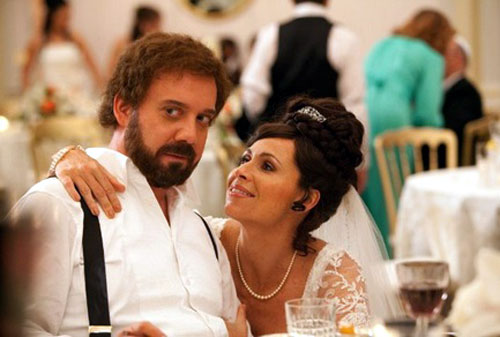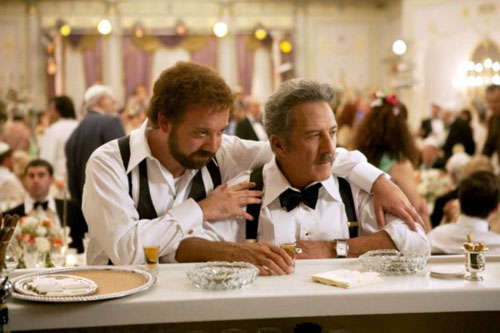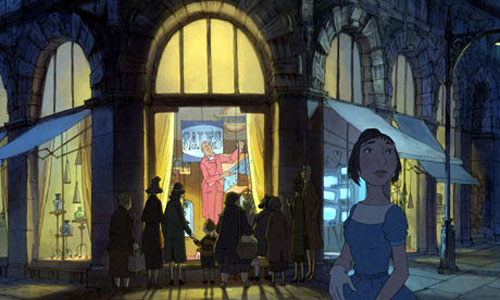|
Paul Giamatti specializes in playing rogues, scamps and grouches who are lovable largely because he plays them. It's hard to think of any other actor so adept at finding the humanity in people who, in real life, you might cross the street to avoid. In American Splendor, he was a far more compelling Harvey Pekar than Pekar himself. In Sideways,we rooted for him even when he stole money from his mother to finance a wine-soaked weekend debauch. He even managed--with no help from anyone, especially not M. Night Shyamalan--to make Lady in the Water watchable (barely).
In Richard J. Lewis' Barney's Version, Giamatti outdoes himself. He plays Barney Panofsky, a man who deserts his new bride at their wedding reception to chase another woman he has just met but whom he has decided is the love of his life. And we love him for it, even as we gasp at his unbridled chutzpah.
Chutzpah, indeed, is the key to Barney's Version, based on the last of the late Mordecai Richler's picaresque novels about guys on the make in Montreal's Jewish community. Michael Konyves' screenplay introduces us to Barney as, Cuban cigar and single-malt Scotch at the ready, he indulges in one of his favorite later-life pastimes: crank-calling his ex-wife's new husband at 3 a.m.
Barney is in need of amusement. As president of Totally Unnecessary Productions and creator of the long-running soap opera, "Constable O'Malley of the North," he is a sufficiently public figure for the bullying Det. O'Hearne (Mark Addy) to gain a lot of publicity for his new book accusing Barney of the murder of his failed-novelist friend Boogie (Scott Speedman) nearly thirty years before.
Publication of the book is the catalyst for Barney to reminisce about the strange and bumpy course of his life, traveling back and forth in time between Rome,Montreal and the Quebec countryside. We learn the mystery surrounding the professional sponger Boogie; we also meet Barney's three ex-wives: Clara (Rachelle Lefevre), a manipulative, high-strung artist who hoodwinks Barney into marrying her; the self-obsessed, never-named Jewish princess (Minnie Driver) who represents Barney's social and financial aspirations; and Miriam (Rosamund Pike), the woman Barney meets at his wedding reception, who does indeed prove to be the love of his life until Barney, of course, screws it up.
 |
Another important character in Barney's life is his raffish father Izzy, played vividly by Dustin Hoffman. A cop with a reputation for brutality and a weakness for hookers and booze, Izzy blasts through life as brazenly as possible, simultaneously warping his son and opening his eyes to life's possibilities. The scene of Barney by his father's deathbed (no fair describing the circumstances) is one of the film's most memorable; Giamatti's laughter-through-tears performance in the scene is the sort of thing that no one, but no one, does better than he.
 |
Like too many movies adapted from literary novels, Barney's Version is flabby and slow in places, particularly in the middle section depicting Barney's happy, pre-breakup years with Miriam. Nevertheless, the film is well worth seeing, thanks to a fine cast and especially Giamatti. His Barney has a rascally twinkle about him and an unabashed love of life, combined with an incongruous edge of neurotic fear (coming out most clearly as his third marriage crumbles) and a faint yet pervasive sense of melancholy. He's the sort of person Woody Allen would be if Woody didn't overintellectualize everything. Giamatti makes Barney such a fully realized character that, when his story takes a poignant turn toward the end, you had better have a few boxes of Kleenex at hand. (Giamatti won a well-deserved Golden Globe award for his performance, but was snubbed by Oscar; this year, unfortunately, he had to get in line with many actors who were similarly robbed, such as Robert Duvall for Get Low and Ryan Gosling for Blue Valentine.)
Directors love their in-jokes, and Richard J. Lewis' is to feature an honor roll of Canadian directors in bit parts: Atom Egoyan and David Cronenberg as directors of "Constable O'Malley of the North;" Ted Kotcheff as a train conductor; Denys Arcand as the maitre d' of a swanky restaurant; and—goofing on his Due South persona—Paul Gross as the actor playing Constable O'Malley. Guy Dufaux, Arcand's usual photographer, envelops Barney's Version in glowing images of jeweled cities and pristine woodlands, recalling his work in The Barbarian Invasions and Decline of the American Empire.
Barney's Version is a fine tragicomic story about an inveterate rogue. Across the Atlantic, meanwhile, Sylvain Chomet has fashioned a film about a totally different type of rogue from Barney Panofsky: Tatischeff the Magician, who is a trickster by profession but far too honest and innocent for that role.
In his last film, The Triplets of Belleville, Chomet paid homage to his hero, Jacques Tati. In his latest, L'Illusionniste (The Illusionist), Chomet creates a full-fledged monument to Tati; the film is based on a screenplay left unproduced when Tati died in 1982, entrusted to Chomet by Sophie Tatischeff, Tati's daughter.
The Illusionist begins in 1959 Paris, where Tatischeff finds his old-fashioned hat-and-rabbit tricks in rapidly decreasing demand. (Among other things, Tatischeff is afflicted with the nastiest rabbit in the world, who bites him and anyone else in biting range.) Forced to accept an engagement on a remote Scottish island, Tatischeff entrances Alice, a young chambermaid who thinks his illusions are real. When Tatischeff leaves for a gig in Edinburgh, Alice stows away on the boat. The rest of The Illusionist concerns the chaste, father-daughter relationship between Tatischeff and Alice, his fumbling efforts to provide for her, and their slow, inevitable estrangement as Alice discovers the larger world on her own. Alice's life expands as Tatischeff's—circumscribed by a dying music-hall culture—constricts.
 |
In more ways than one, The Illusionist is a throwback to an earlier era. As in The Triplets of Belleville, The Illusionist contains no computer-generated images; everything is hand-drawn, exquisitely. Chomet's vistas of the Scottish coast recall the Impressionists; his panoramas of Edinburgh, the great castle looming over the city, evoke childhood memories of fairy tales. They are awe-inspiring in a way that CGI, amazing as its effects can be, has not achieved.
But leaving aside even its traditional technique, The Illusionist evokes an older, gentler world. The key to this is in the comedic style of Tati, a style that will seem odd to Americans used to nonstop laughs.
Here's where the critic's personal confession comes in: to date I have seen only one Tati film, his most popular and arguably his greatest: Les Vacances de Monsieur Hulot (Monsieur Hulot's Holiday). I could write a column about Monsieur Hulot's Holiday alone, but my point is how perfectly Chomet captures Tati's style. The character of Hulot was virtually a human question mark; his typical posture was bent forward, hands on hips, pipe stuck at an angle from his mouth as he quizzically scrutinized everyone and everything in his view.
But although Tati unquestionably was the auteur of Monsieur Hulot's Holiday, neither he nor Hulot could truly be said to be the star. The varied group of vacationers—many of them as eccentric as Hulot—were as much the film's stars as he, along with the rocky seashore filmed in pristine black-and-white and the ramshackle little beachfront hotel, the comings and goings of its guests punctuated by the thonk-thonk-thonk of the dining-room door.
Some of the gags in Monsieur Hulot's Holiday are as hilarious as anything Chaplin or Keaton ever did; I need only mention the kayak, the horse, and the fireworks shed to elicit appreciative grins from those who have seen the film. But the gags are not the film's point; most of its scenes begin and end quietly, little slices of life as the hotel's guests go swimming or boating, play records or cards, walk along the beach. The dialogue in Monsieur Hulot's Holiday is sparse and mostly ambient, no more to be sorted out than the sound of the ocean waves. (The same is true of both The Illusionist and The Triplets of Belleville; it is here that Tati's influence on Chomet is particularly clear.) Monsieur Hulot wanders through the film, punctuating the scenes but only occasionally dominating them. The film and everything in it is inconclusive; the characters come to the hotel, spend time together, and leave. The only bit of color in the film is the red postage stamp at the very end, as the final scene of the now-deserted hotel and beach is transformed into a picture postcard. Monsieur Hulot's Holiday is about the passing scene, about lives that ebb and flow like the ocean. Roger Ebert said aptly that no other film so captures the essence of nostalgia.
It is that very nostalgia Chomet captures in The Illusionist. I have heard Chomet made changes in the original script that members of Tati's family did not like; nevertheless, The Illusionist evokes a melancholy that to me seems very much in keeping with the spirit of Tati. There might be the occasional rowdy outburst from a Chevy-driving American or an English rock-'n-roll band (two phenomena about which Tati and Chomet share an extremely low opinion), but the film is about how life and the world change—for the better for some, for the worse for others. The theatrical hotel where Tatischeff and Alice stay in Edinburgh is a microcosm of people left behind. At one point we see the resident ventriloquist checking out, presumably to leave for another gig, but a few minutes later we see his dummy in the window of a pawnshop. Similarly, the acrobatic brothers inhabiting the hotel can only find work painting signs, and the requisite sad clown is prevented from hanging himself only by Alice's opportune offer of a bowl of homemade stew. Meanwhile, Chomet's panoramic sweeps of the Royal Mile show in passing a store filled with television sets.
Wandering through it all is Tatischeff, forever misprized and cheated, going wherever he can unroll his poster and unpack his moth-eaten top hat. He is the chief source of whatever gags and jokes the movie has, but his air of sad dignity dampens any laughter. (At one point Tatischeff wanders into a cinema showing Mon Oncle, allowing Chomet to have Tati confront himself.) By the time Tatischeff leaves Alice his brief, poignant parting note, Alice has already realized for herself what Tatischeff tells her. Some reviewers have described Alice as an ingrate, and perhaps she is. But Edinburgh proves to be a very different place for her than for Tatischeff.
Despite the film's pervasive air of melancholy, there are still touches of life, laughter and hope, especially in the person of the drunken, kilted Scotsman who turns up everywhere Tatischeff goes. (Be sure to watch the credits to the very end; as in The Triplets of Belleville, Chomet has a little surprise for us.) The Illusionist isn't for people who like their animation Disneyfied, but for those with the patience for something slower and more poetic, it's a gem.
|

